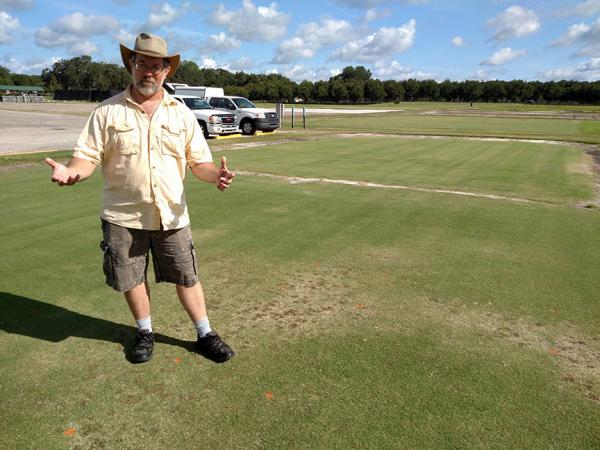Nematode control was a whole lot easier when all that was needed to keep the pests in check on putting greens and fairways was a jug of Nemacur and a reliable hazmat suit.
 Regardless of the temperature, pest species, turf type or geographic location, fenamiphos, the active ingredient in Nemacur, was the end-all, be-all for nematode management. Now that Nemacur no longer is available, nematode control is not impossible, but success requires much more homework by professional turfgrass managers.
Regardless of the temperature, pest species, turf type or geographic location, fenamiphos, the active ingredient in Nemacur, was the end-all, be-all for nematode management. Now that Nemacur no longer is available, nematode control is not impossible, but success requires much more homework by professional turfgrass managers.Products that have made it to market since Nemacur and other fell victim to to the U.S. Environmental Protection Agency's Food Quality Protection Act of 1996, share some of its properties, but nothing does everything Nemacur did. Some have systemic activity, some are contact products that get bound in the thatch layer, while others work deeper into the soil. Some work on sting nematodes, but not lance and vice versa.
"Nemacur had contact and systemic activity. We have nematodes that live in the soil and some that live inside the roots. Nemacur worked on all of those," said University of Florida nematologist Billy Crow, Ph.D.
"The first group of old chemistries the EPA looked at were organophosphates. They are nerve toxins and work on anything with a nervous system: nematodes, insects, birds, fish, dogs, people.
"You couldn't get something like that labeled today."
Trials at the University of Florida's research facility in Citra, located between Ocala and Gainesville, focus on much more than how efficiently they can extinguish nematodes.
"We're not looking just at efficacy, but how nematodes move in the soil," Crow said.
"We're also looking at non-target effects. We have several concerns, because we are using a lot of nematicides at high rates and frequent applications. What kind of effects are we having on non-target organisms?"
Federal regulations today require data on how new chemistries affect bees and worms.
Success in fighting nematodes today requires multiple products in a rotational program. According to the EPA, there is no scientific data to support the hypothesis that nematodes can develop resistance to any specific chemistry. The agency, however, recommends rotating products just to be certain, and so does Crow.
Nemacur worked at the surface, in the soil, in the plant and on contact. Products that have replaced it have some of the traits that made it so popular, but it's like picking, not from an all-you-can-eat buffet, but rather from an a la carte menu where users get a little of this and a little of that.
"Abamectin binds in the thatch. You can spray it at the surface, irrigate it in and only 1 percent will make it through the thatch. Root knot nematodes stay in the thatch layer, so it works on that, but it's not so good on other nematodes," Crow said.
"If you have a product that works on sting nematodes, but not lance, your sting numbers go down, but then your lance nematode numbers might go up. If you use that product repeatedly, you can develop a lance nematode problem. We have to rotate chemistries to manage different nematodes at different times of the year."
The first group of old chemistries the EPA looked at were organophosphates. They are nerve toxins and work on anything with a nervous system: nematodes, insects, birds, fish, dogs, people. You couldn't get something like that labeled today."
Other studies at Florida include using a box camera that takes high-quality digital images used to inspect color and determine turf quality based on nematicide use, and incorporating compost containing actinomyces with Comand topdressing for nematode control.
In micro plots at the Citra research facility, Crow has observed 95 percent control of sting nematodes with the Comand topdressing-actinomyces compost mix, and studies are under way to determine whether the combination can be used to control sting nematodes at the surface during topdressing applications.
Other trials are showing that TifTuf Bermudagrass developed by researchers at the University of Georgia, not only is drought tolerant, but also has a root mass healthy enough to stand up to nematode-related stress better than most other warm-season grasses.
"The more roots you have, the more nematodes you can tolerate," Crow said. "If you have fewer roots, you can't tolerate as many.
"Shear number of nematodes is not as important as how the grass is going to perform."
In the end, superintendents today have to know a lot more about nematodes than they did when Nemacur was the standard for control.
"New products work better on some nematodes than others. You have to know what kind of nematode you are going to manage. Which product to use and when you use it are important," Crow said. "Some nematodes are in different places in the soil depending on the time of year. Some are going to be deeper in the soil in the summer, so you have to put something that is going to move deeper. When it's cooler, some will stay higher, so you have to use something that stays in the top part of the soil. You have to know a lot more about what you are doing, the nematology and their behavior."

